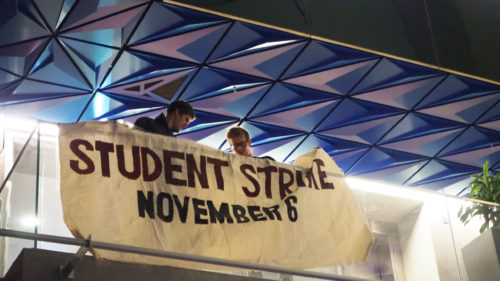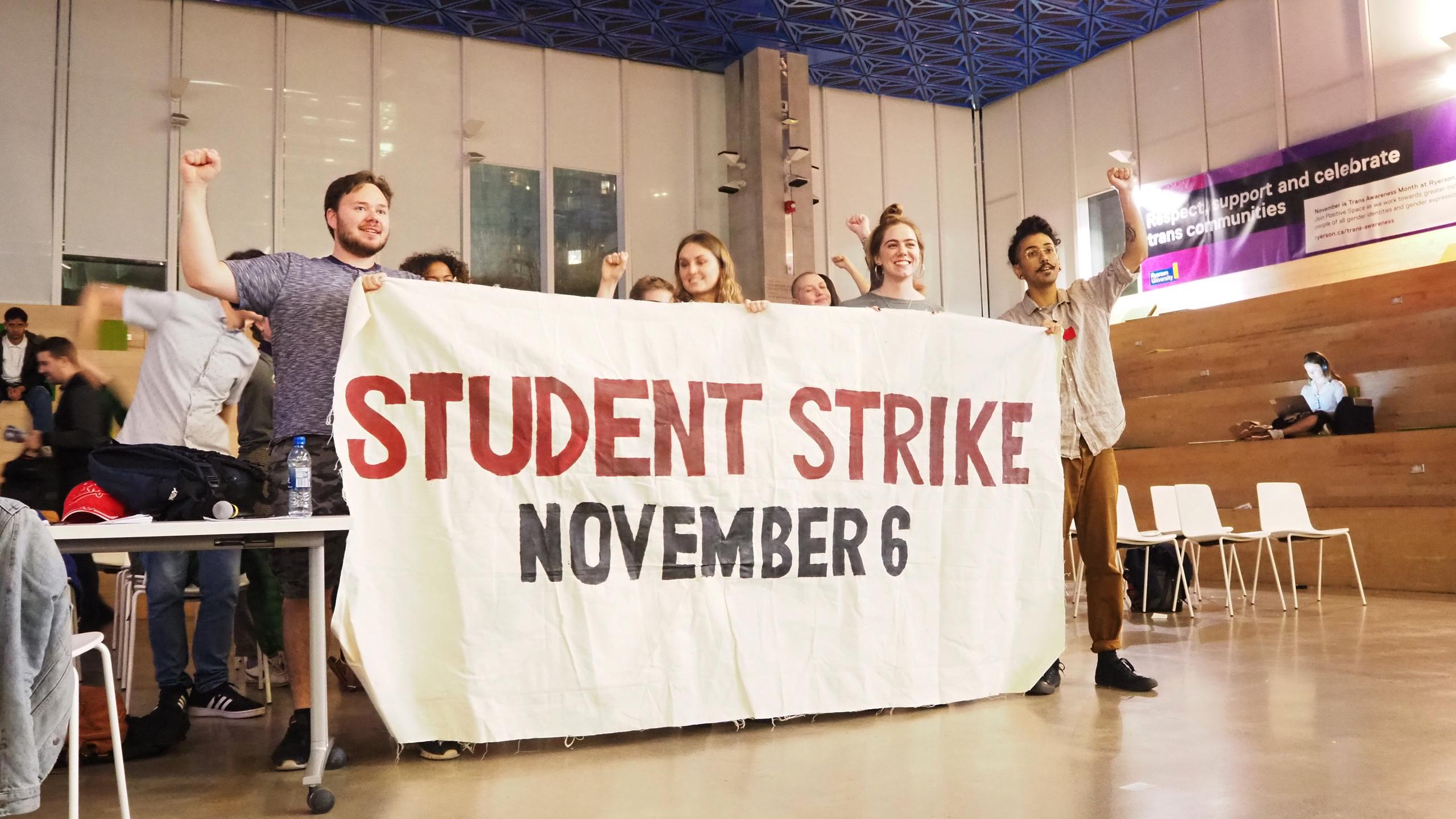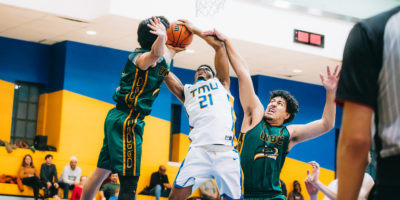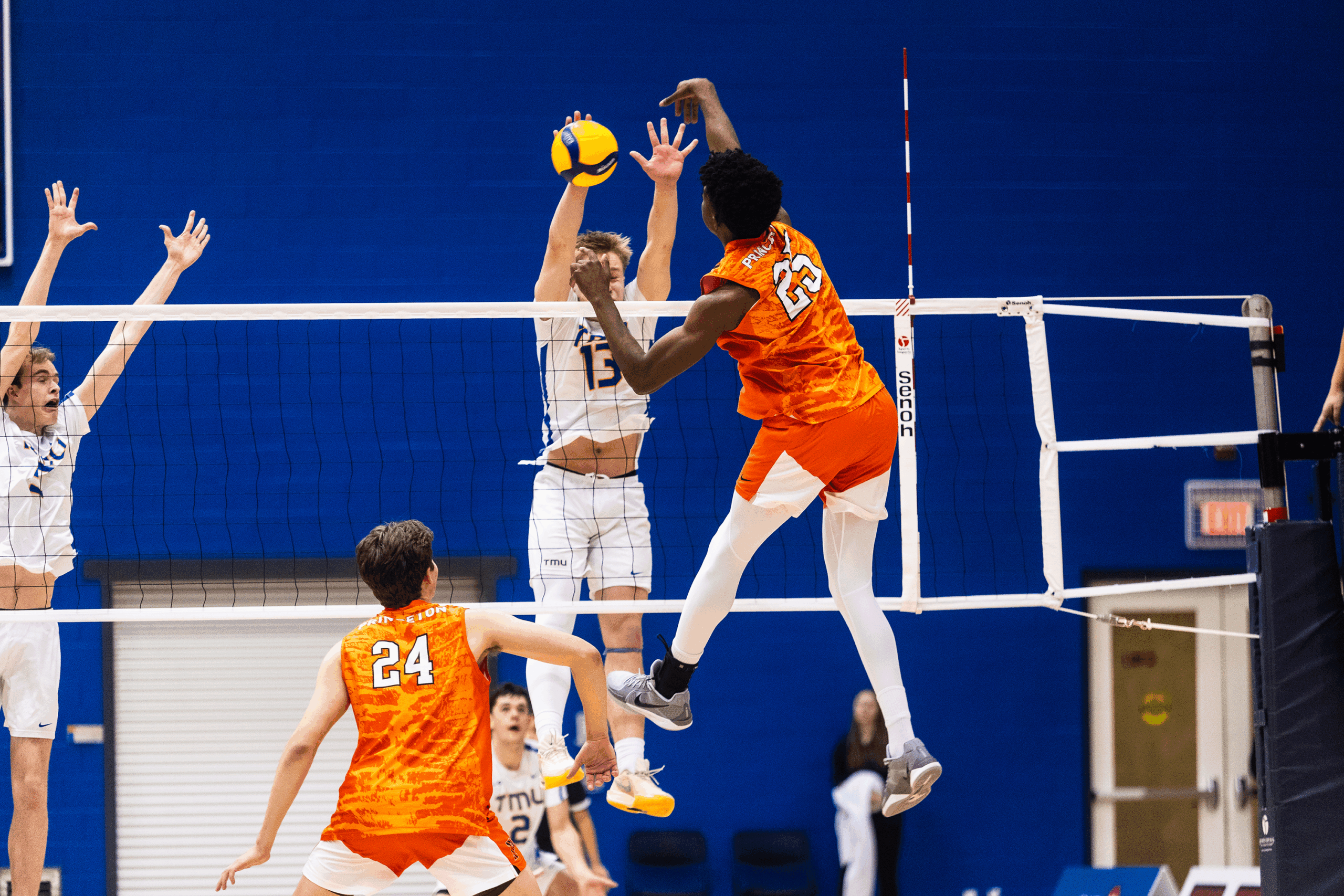By Heidi Lee and Valerie Dittrich
The Ryerson Students’ Union (RSU) and Continuing Education Students’ Association of Ryerson (CESAR) are encouraging students to join the student strike through a “soft introduction,” according to CESAR president Nicole Briayiannis.
“We are trying to target the group of students who are not yet engaged [with the strike],” Briayiannis told the attendees at the second Ryerson Student Strike (RSS) general assembly. The general assembly took place on Wednesday at the Sheldon and Tracy Levy Student Learning Centre (SLC).
RSU and CESAR will be partnering with the RSS campaign to execute a one-day student strike.
In an interview with RSU vice-president education, Kwaku Agyemang said that the partnership is to make sure the RSU and RSS are not working against each other on campus.
“We are doing this at Ryerson in solidarity with other students’ unions in the GTA area,” said Agyemang. “We hope that the message is clear towards decision-makers.”
He said the students’ union knows students are upset about the cuts to the Ontario Student Assistance Program (OSAP). “We know that a lot of students are passionate [but] it is just the matter of executing [the strike] in the right way,” said Agyemang.
On Jan. 17, 2019, the provincial government announced that OSAP would be reverting back to the 2016-17 framework.
This meant that grants were decreased, free tuition for students whose families who made under $50,000 a year was scrapped and interest would be charged during the six-month grace period. It also included the introduction of the Student Choice Initiative (SCI), which allowed students to opt out of paying certain ancillary fees this past August and September.
Although no one on the RSU’s executive team was present, an RSU representative, Micah Ricardo, attended the general assembly and spoke on behalf of the union.
“We need to work in solidarity within the day and we want to make sure that wouldn’t change,” said Ricardo.
The RSU previously voted down the RSS’ motion to have the RSU and CESAR “publicly” support a one-day strike at an Oct. 22 Board of Directors (BoD) meeting.
Previous disagreements over planned day of action
Agyemang cited previous concerns with the accessibility of the RSS’ Sept. 25 general assembly—where over 200 people voted in favour of holding and executing a one-day student strike. He said it was unclear that everyone who voted at that assembly was indeed a Ryerson student.
When asked by Hung Le, Faculty of Communications and Design (FCAD) director during the Oct. 22 BoD meeting if Azam could confirm that everyone who voted during the Sept. 25 general assembly was a Ryerson student, Azam said that attendees were “not all Ryerson students.”
“We had support from the labour movement, NDP MPP Chris Glover, we had graduate students, campus workers, the fact is that…The majority of the crowd was students and out of that crowd one person voted against it,” he said.
During a sit-in outside of the RSU offices on Oct. 9, Agyemang and Briyiannis said the RSU and CESAR would be releasing a survey asking students if they would prefer a day of action or a student strike.
While the details of the day of action were undefined, the RSU said it could involve anything from a walkout to soft picket lines on campus. RSS previously said they would prefer hard picket lines if students were granted academic amnesty from the university.
Agyemang said he didn’t want to make a decision on whether or not to endorse the Nov. 6 strike before their survey ended on Oct. 25.
According to Agyemang, in order for the university to consider granting students academic amnesty for the strike, the survey would need feedback from at least 20 per cent of the Ryerson population—meaning 8,000 students out of an estimated 40,000 would have had to provide feedback in the survey.
He said the survey garnered just under 1,000 responses from students and most of the responses said they were in favour of executing a strike.
Soft picket v.s. hard picket

Hermes Azam, the spokesperson for RSS and former president of Socialist Fightback, said the strike will be in the form of a soft picket line.
“A picket line is an old tradition from the labour movement when the workers leave their workplace and form a human chain around their workplace,” said Azam.
He said the main picket line will be set up in front of the SLC and RSS, and that he encourages students to be there at 7 a.m. There will also be a picket line in front of the Student Campus Centre (SCC).
Briayiannis said the picket line would be running all day and there will be a march in the afternoon.
According to Azam, the main “picket captains” will be himself and Marco La Grotta—a Ryerson graduate and editor of Fightback, a publication by Socialist Fightback.
Agyemang said the main concern is to decide whether to do a soft picket line or a hard picket line on Nov. 6. A hard picket would have the university shut down, as entries to the school would be blocked.
The vice-president education said that while the strike has support from some faculty, he recognizes that some students may be penalized for missing class.
“We want to make sure we protect the students that still have the regular class, and educate students on the risk of striking but also educating students on the importance [of striking] in the long term,” said Agyemang.
Three motions passed
The RSS also passed three motions during the general assembly.
Before voting on the motions around requesting academic amnesty for the school, banning unpaid student labour and their list of demands to the provincial government, Olive Pape, outreach organizer of RSS and member of Fightback, told the attendees only Ryerson students were allowed to vote.
However, it is unclear what type of measurement was used to ensure that voters were registered Ryerson students. The Eyeopener reached out to Azam to ask about this but did not receive a response in time for publication.
Up first was a motion for the RSS committee to request amnesty on Nov. 6 for students and employees. This would mean students and employees would not be penalized for missing class.
The second motion was to add an amendment to RSS’ existing demands—to ban all unpaid student labour and support the curation of paid placements.
Lastly, RSS added the second motion to the existing list of demands and asked the audience to vote on them as a whole.
The seven demands include stopping the cuts to OSAP, eliminating all tuition fees for domestic and international students, defending the right to repeal the Student Choice Initiative and cancelling all student debt.
Azam said students would have to keep the conversation going and make sure that this movement doesn’t die after the strike.
“We need to learn from those before us,” he said. “Learning lessons from those across the world today, [like in] Chile, Hong Kong and so on.”











Leave a Reply